IoT networking is revolutionizing the way devices connect and communicate, enabling automation and real-time data collection across various sectors. Technologies such as LoRaWAN, NB-IoT, Wi-Fi 6, and 5G provide tailored solutions for different connectivity needs, enhancing efficiency and decision-making. By leveraging these networks, organizations can gather valuable insights and streamline operations, ultimately driving innovation and growth.
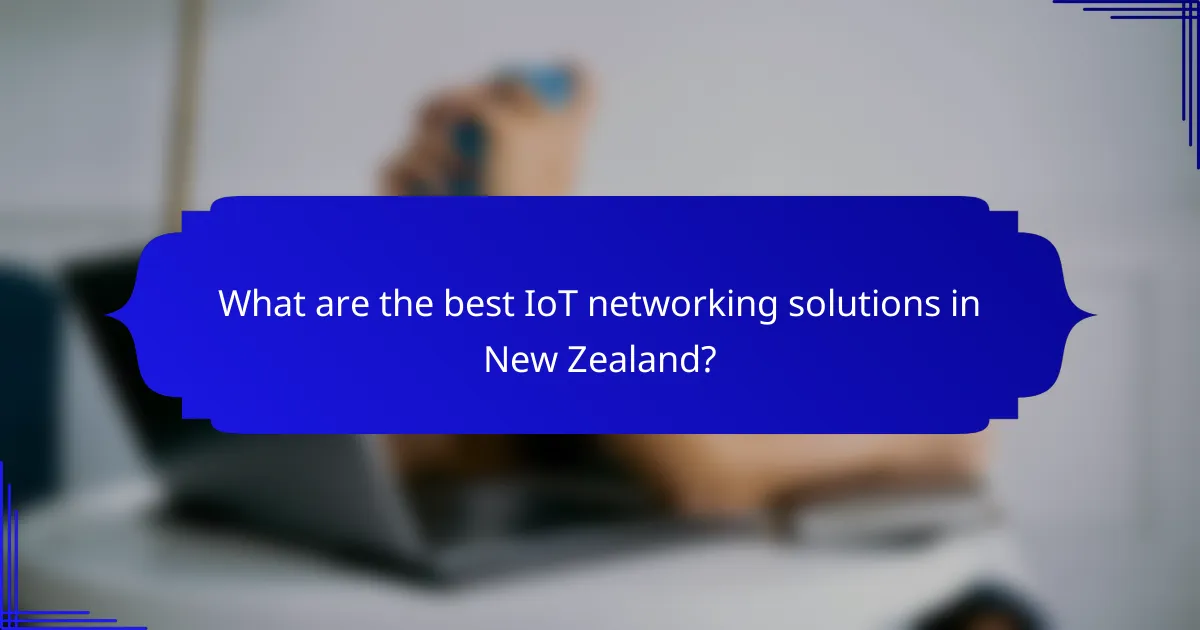
What are the best IoT networking solutions in New Zealand?
The best IoT networking solutions in New Zealand include LoRaWAN, NB-IoT, Wi-Fi 6, and 5G networks. Each technology offers unique advantages depending on the specific requirements of connectivity, power consumption, and data transfer speed.
LoRaWAN for long-range connectivity
LoRaWAN is ideal for long-range communication, making it suitable for applications like agriculture and smart cities. It operates in the sub-GHz frequency bands, allowing devices to connect over distances of several kilometers while consuming minimal power.
When implementing LoRaWAN, consider the density of your devices and the terrain. Urban environments may require more gateways to ensure coverage, while rural areas can benefit from its extensive range. Common use cases include environmental monitoring and asset tracking.
NB-IoT for low-power applications
NB-IoT (Narrowband IoT) is designed for low-power, low-bandwidth applications, making it perfect for smart meters and sensor networks. It operates on existing cellular networks, providing reliable connectivity with a focus on energy efficiency.
In New Zealand, NB-IoT can support devices that need to transmit small amounts of data infrequently. This technology is particularly useful for applications where battery life is critical, often lasting several years on a single charge. Ensure that your devices comply with local regulations for cellular connectivity.
Wi-Fi 6 for high-speed data transfer
Wi-Fi 6 offers high-speed data transfer and improved capacity, making it suitable for environments with many connected devices. It supports faster speeds and lower latency, enhancing the performance of IoT applications in homes and businesses.
When deploying Wi-Fi 6, consider the network’s coverage area and the number of devices. This technology is particularly effective in dense environments, such as offices or smart homes, where multiple devices operate simultaneously. Ensure your infrastructure can handle the increased data load.
5G networks for real-time applications
5G networks provide ultra-low latency and high data rates, making them ideal for real-time applications like autonomous vehicles and remote surgery. With speeds significantly faster than previous generations, 5G supports a vast number of connected devices simultaneously.
In New Zealand, leveraging 5G requires compatible devices and infrastructure. Consider the deployment of edge computing to minimize latency further. As 5G continues to roll out, keep an eye on coverage maps to ensure your applications can fully utilize this technology’s capabilities.
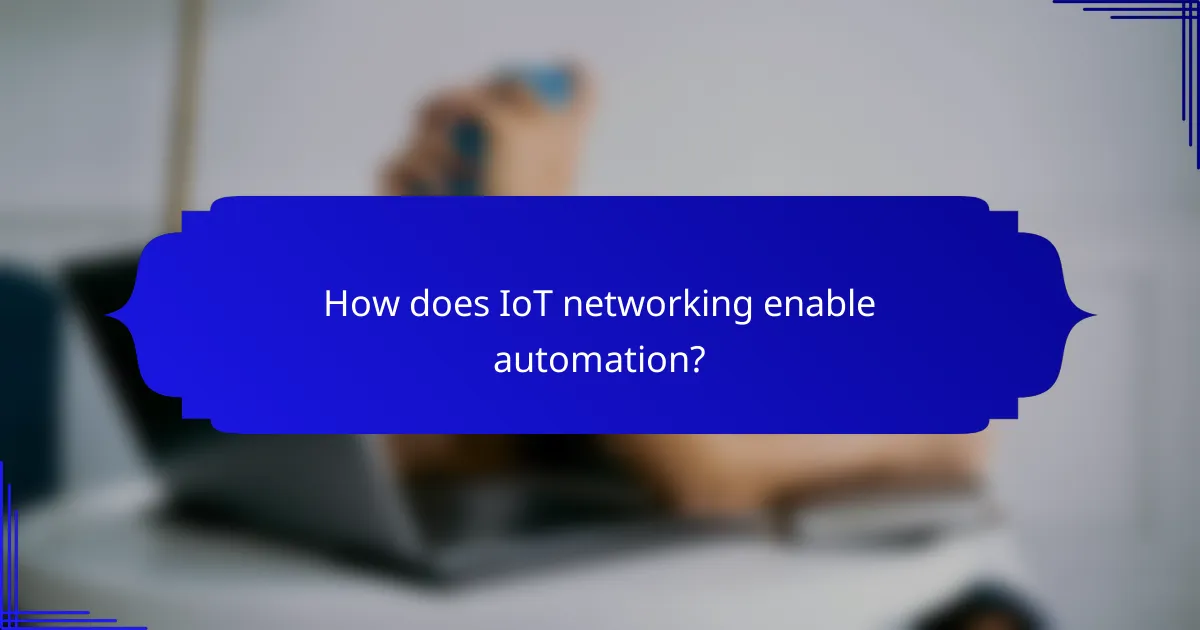
How does IoT networking enable automation?
IoT networking facilitates automation by connecting devices that can communicate and perform tasks without human intervention. This connectivity allows for real-time data collection and analysis, enabling systems to make decisions and execute actions automatically.
Remote monitoring and control
Remote monitoring and control are essential features of IoT networking that empower users to oversee and manage devices from afar. For example, a user can monitor energy consumption in their home through a mobile app and adjust settings accordingly, leading to energy savings and enhanced efficiency.
Consider implementing remote control systems for critical applications, such as industrial machinery or agricultural equipment. This allows for timely interventions, reducing downtime and improving productivity. However, ensure that your network is secure to prevent unauthorized access.
Smart home integration with platforms like Google Home
Smart home integration with platforms like Google Home allows users to automate various household tasks through voice commands or scheduled routines. Devices such as smart lights, thermostats, and security cameras can be seamlessly connected, enabling a cohesive smart home experience.
When integrating devices, ensure compatibility with your chosen platform and consider the ease of use. For instance, using a single app to control all devices simplifies management. Additionally, regularly update device firmware to maintain security and functionality.
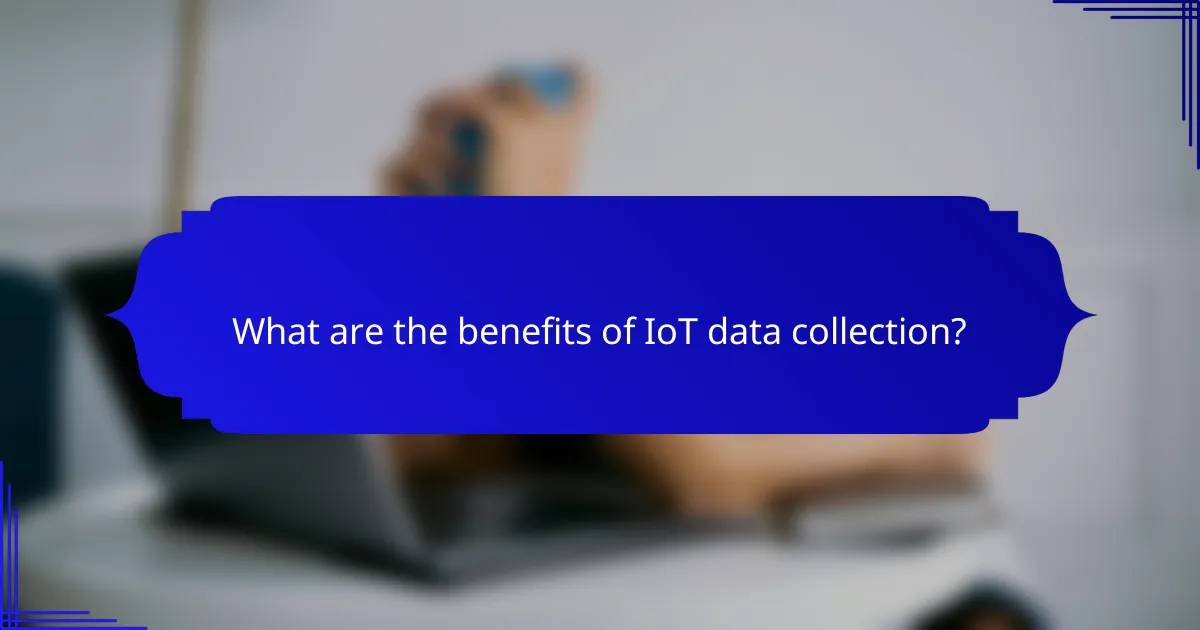
What are the benefits of IoT data collection?
IoT data collection offers significant advantages, including improved insights and enhanced efficiency across various sectors. By gathering and analyzing data from connected devices, organizations can make informed decisions and optimize their operations.
Improved decision-making through analytics
Data collected from IoT devices enables organizations to leverage analytics for better decision-making. By analyzing trends and patterns, businesses can identify opportunities for growth and areas needing improvement. For instance, retailers can use customer behavior data to tailor marketing strategies and inventory management.
To maximize the benefits of analytics, companies should focus on integrating real-time data processing capabilities. This allows for quicker responses to changes in consumer behavior or operational challenges, enhancing overall agility.
Enhanced operational efficiency
IoT data collection significantly boosts operational efficiency by automating processes and reducing manual intervention. For example, smart sensors in manufacturing can monitor equipment health, predicting maintenance needs and minimizing downtime. This proactive approach can lead to substantial cost savings.
Organizations should consider implementing IoT solutions that provide actionable insights, such as energy consumption data. By analyzing this information, businesses can identify inefficiencies and optimize resource usage, potentially lowering operational costs by a notable percentage.
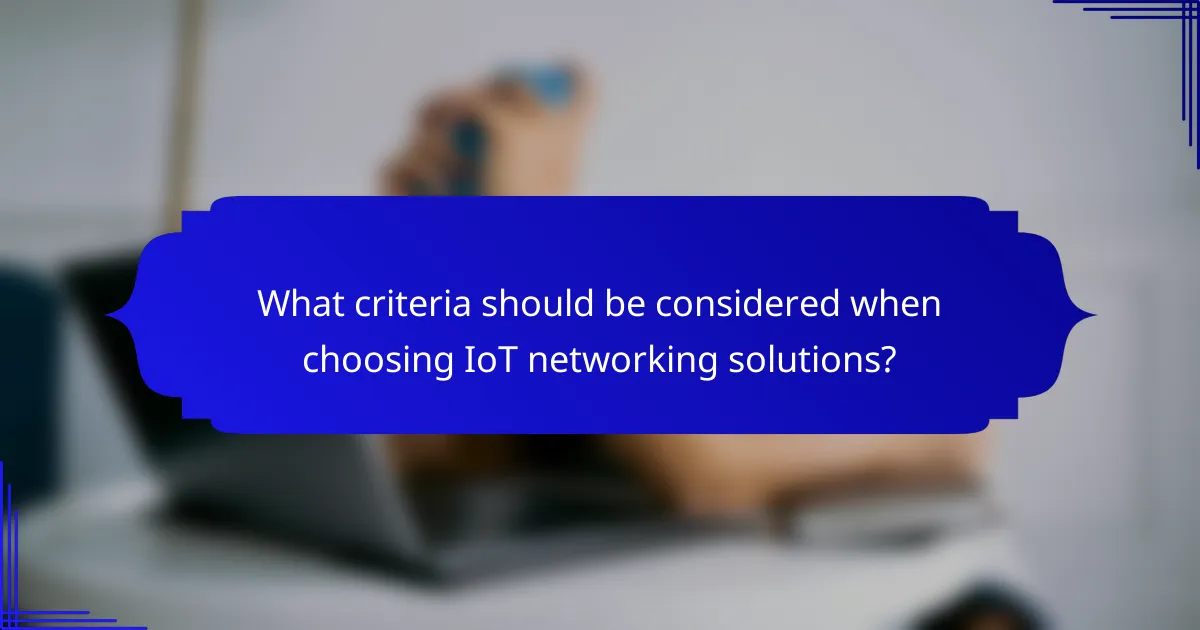
What criteria should be considered when choosing IoT networking solutions?
When selecting IoT networking solutions, key criteria include scalability, security, compatibility, and cost-effectiveness. These factors ensure that the chosen solution can grow with your needs while protecting sensitive data and integrating seamlessly with existing systems.
Scalability for future growth
Scalability is crucial for IoT networking solutions as it allows for the addition of more devices and services without significant overhauls. Consider solutions that support a wide range of devices and can handle increased data traffic as your network expands.
Look for platforms that offer cloud-based services or edge computing capabilities, as these can easily scale to accommodate growing demands. A good rule of thumb is to choose a solution that can support at least double your current device count to ensure future flexibility.
Security features to protect data
Security is a top priority when choosing IoT networking solutions, as these networks often handle sensitive information. Ensure that the solution includes robust encryption protocols, secure authentication methods, and regular software updates to protect against vulnerabilities.
Additionally, consider solutions that comply with industry standards such as GDPR or HIPAA, depending on your sector. Implementing a multi-layered security approach, including firewalls and intrusion detection systems, can further enhance data protection in your IoT network.
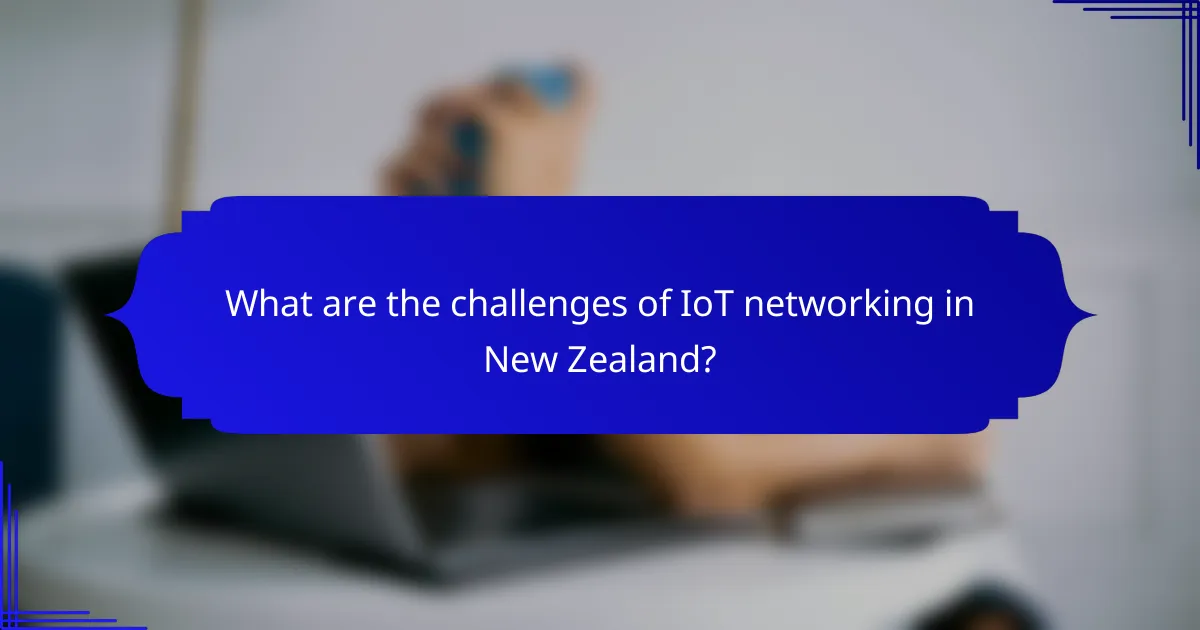
What are the challenges of IoT networking in New Zealand?
The challenges of IoT networking in New Zealand primarily revolve around network coverage, particularly in rural areas, and concerns regarding data privacy. These issues can significantly impact the effectiveness and reliability of IoT solutions across the country.
Network coverage limitations in rural areas
In New Zealand, rural areas often face significant network coverage limitations, which can hinder the deployment of IoT devices. Many regions lack robust cellular or broadband infrastructure, making it difficult to maintain consistent connectivity for IoT applications.
To address this, businesses should consider using satellite or low-power wide-area network (LPWAN) technologies, which can provide better coverage in remote locations. However, these solutions may come with higher costs or lower data transmission rates, so weighing the trade-offs is essential.
Data privacy concerns
Data privacy is a critical concern for IoT networking in New Zealand, as the collection and transmission of personal information can expose users to risks. The Privacy Act 2020 governs how personal data should be handled, emphasizing the need for transparency and security in IoT systems.
Organizations should implement strong encryption and access controls to protect data. Regular audits and compliance checks can help ensure that IoT solutions align with legal requirements and best practices, reducing the risk of data breaches and enhancing user trust.
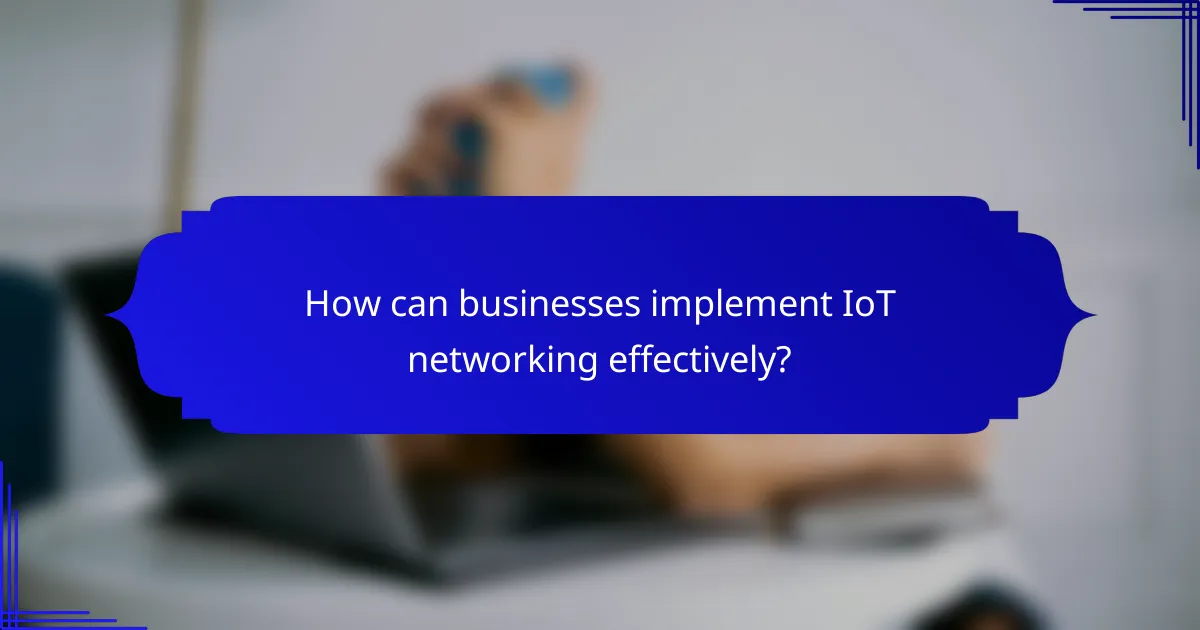
How can businesses implement IoT networking effectively?
Businesses can implement IoT networking effectively by strategically planning their infrastructure, defining clear use cases, and selecting suitable technologies. This approach ensures that the integration of IoT devices aligns with organizational goals and maximizes operational efficiency.
Step 1: Assess current infrastructure
The first step in implementing IoT networking is to evaluate the existing infrastructure. This includes assessing current hardware, software, and network capabilities to determine what can support IoT devices and applications.
Identify any gaps in connectivity, processing power, or security that may hinder IoT deployment. Consider factors like bandwidth availability and latency, as these will affect the performance of IoT solutions.
Step 2: Define specific use cases
Clearly defining specific use cases is crucial for effective IoT networking. Businesses should identify the problems they aim to solve or the efficiencies they wish to achieve through IoT technology.
For example, a manufacturing company might focus on predictive maintenance to reduce downtime, while a retail business could implement smart inventory management to optimize stock levels. Prioritizing use cases based on potential ROI can guide implementation efforts.
Step 3: Choose appropriate technologies
Selecting the right technologies is essential for successful IoT networking. Businesses should evaluate various connectivity options such as Wi-Fi, cellular, or LPWAN, depending on their specific requirements like range and power consumption.
Additionally, consider the compatibility of devices and platforms with existing systems. Investing in scalable solutions that can adapt to future needs will help ensure long-term success in IoT initiatives.
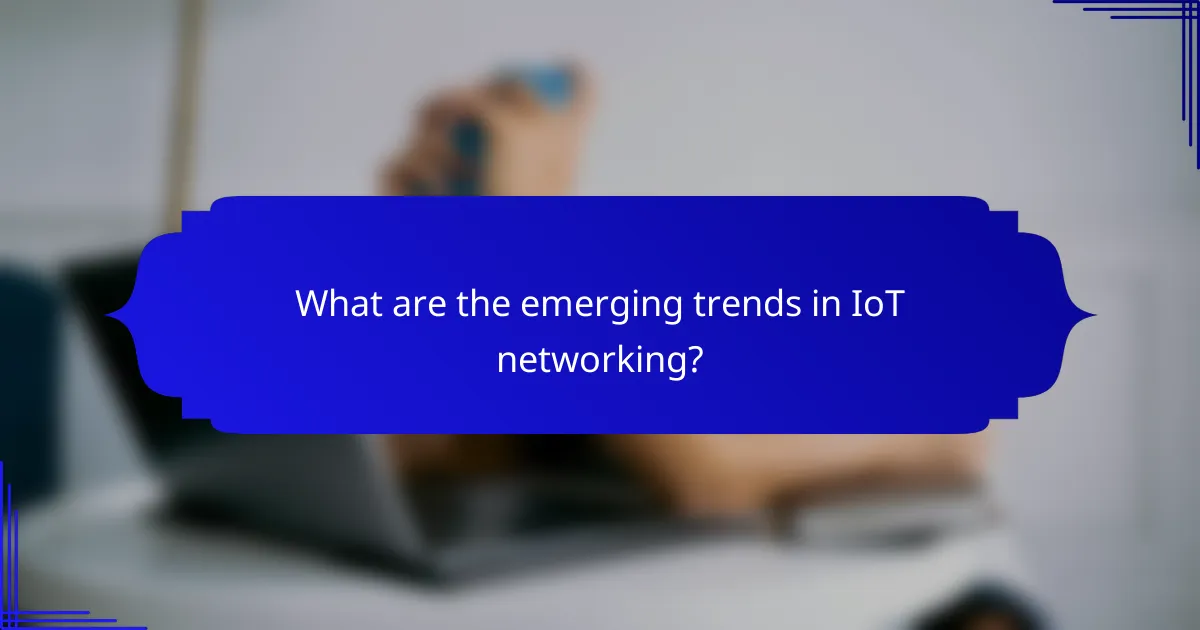
What are the emerging trends in IoT networking?
Emerging trends in IoT networking focus on enhancing connectivity, improving automation, and optimizing data collection. Key developments include the rise of edge computing and the integration of artificial intelligence, which together streamline processes and enhance the efficiency of IoT systems.
Increased adoption of edge computing
Edge computing refers to processing data closer to the source rather than relying on centralized data centers. This trend reduces latency, improves response times, and minimizes bandwidth usage, making it particularly beneficial for applications requiring real-time data processing, such as autonomous vehicles and smart manufacturing.
Organizations should consider deploying edge devices that can handle data processing locally. This can lead to significant cost savings and improved performance, especially in environments with limited connectivity. For example, a factory using edge computing can analyze machine data instantly, allowing for immediate adjustments to optimize production.
Integration with artificial intelligence
The integration of artificial intelligence (AI) into IoT networking enhances data analysis and decision-making processes. AI algorithms can process vast amounts of data collected from IoT devices, identifying patterns and making predictions that improve operational efficiency and automation.
Businesses can leverage AI to automate routine tasks, such as predictive maintenance in industrial settings, reducing downtime and maintenance costs. It is crucial to ensure that AI systems are trained on relevant data to maximize their effectiveness. Organizations should also be aware of the ethical considerations and data privacy regulations that may apply when implementing AI in IoT environments.
